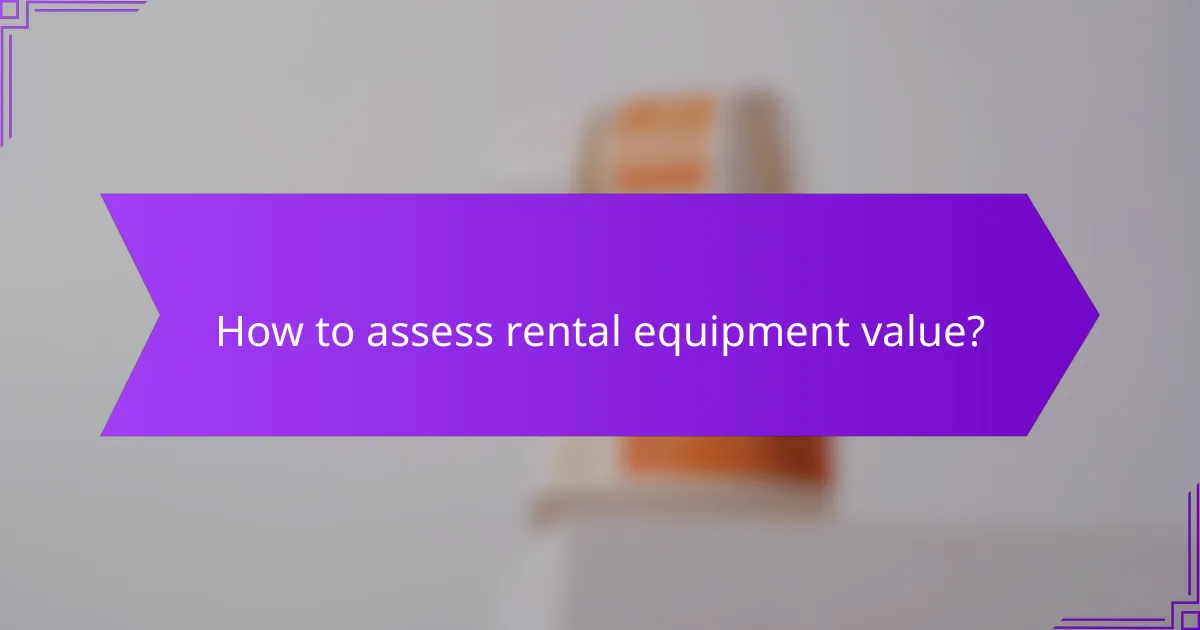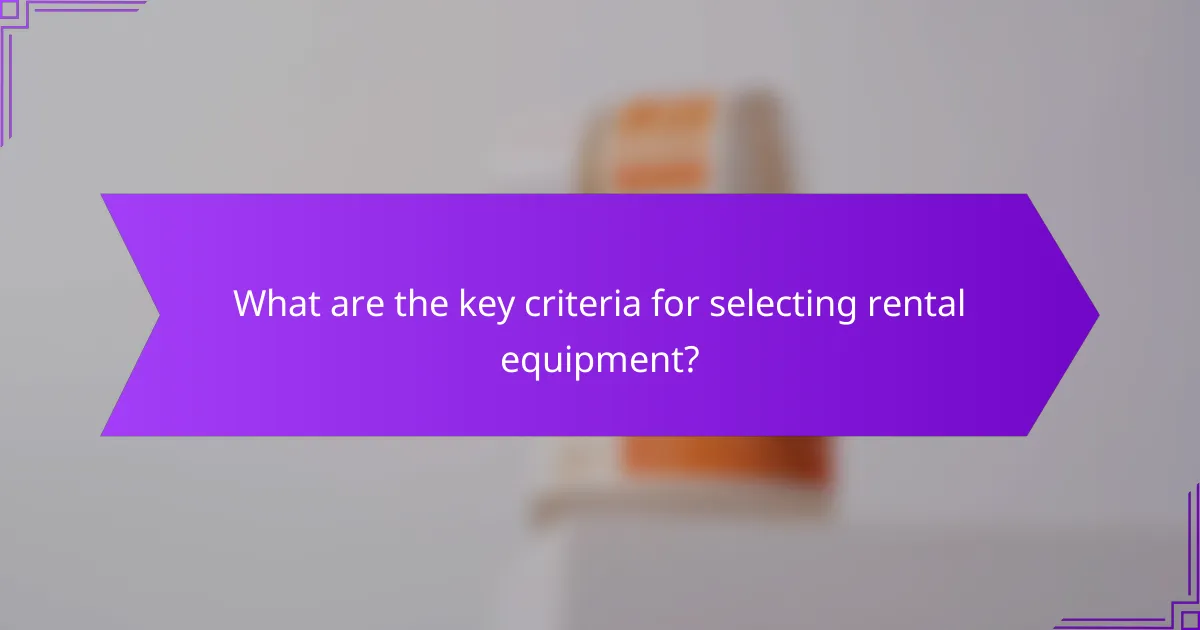When it comes to rental equipment, choosing the right tools like excavators, scissor lifts, and generators can significantly impact the success of your project. It’s essential to consider factors such as quality, performance, and value to ensure you select equipment that meets your specific needs. By evaluating the manufacturer’s reputation, maintenance history, and user reviews, you can make informed decisions that lead to optimal results.

What are the best rental equipment options in the United States?
The best rental equipment options in the United States include excavators, scissor lifts, and generators, each offering unique advantages for various projects. Selecting the right equipment depends on your specific needs, such as project size, terrain, and power requirements.
Excavators from Caterpillar
Caterpillar excavators are renowned for their durability and performance, making them a top choice for heavy-duty excavation tasks. These machines come in various sizes, from compact models suitable for tight spaces to larger units designed for extensive earthmoving.
When renting an excavator, consider factors such as the machine’s operating weight, digging depth, and attachment compatibility. Caterpillar models often feature advanced technology for improved fuel efficiency and operator comfort, which can enhance productivity on the job site.
Scissor lifts from JLG
JLG scissor lifts are ideal for indoor and outdoor projects that require vertical access. These lifts provide a stable platform for workers, making them suitable for tasks like maintenance, construction, and installation at heights ranging from 10 to 50 feet.
When renting a scissor lift, assess the lift’s weight capacity, platform size, and terrain capability. JLG models often include features like electric or diesel power options, allowing you to choose based on your project’s specific requirements and environmental considerations.
Generators from Honda
Honda generators are known for their reliability and fuel efficiency, making them a preferred choice for powering tools and equipment on job sites. These generators range from portable models for small tasks to larger units capable of supporting heavy machinery.
When renting a generator, evaluate the wattage requirements of your equipment and the expected runtime. Honda generators typically offer quiet operation and low emissions, which can be beneficial for projects in residential areas or noise-sensitive environments.

How to evaluate rental equipment quality?
To evaluate rental equipment quality, focus on the manufacturer’s reputation, the maintenance history of the equipment, and performance reviews from previous users. These factors provide a comprehensive view of the equipment’s reliability and suitability for your needs.
Manufacturer reputation
The reputation of the manufacturer is a critical indicator of equipment quality. Established brands often have a track record of producing durable and reliable machinery, which can lead to fewer breakdowns and better performance.
Research the manufacturer’s history, customer service, and warranty policies. Look for brands that are known for their commitment to quality and innovation in the equipment rental industry.
Maintenance history
Understanding the maintenance history of rental equipment is essential for assessing its current condition. Equipment that has been regularly serviced and maintained is likely to perform better and have a longer lifespan.
Ask the rental company for documentation on maintenance records, including any repairs and inspections. A well-maintained piece of equipment can save you time and money by reducing the risk of unexpected failures during use.
Performance reviews
Performance reviews from past users provide valuable insights into how well the equipment operates in real-world conditions. Look for reviews that discuss reliability, ease of use, and any issues encountered during operation.
Consider checking online platforms or forums where users share their experiences. High ratings and positive feedback can indicate that the equipment is a good choice for your rental needs, while consistent complaints may signal potential problems.

What factors influence rental equipment performance?
Rental equipment performance is primarily influenced by load capacity, fuel efficiency, and durability ratings. Understanding these factors helps users select the right equipment for their specific needs, ensuring optimal results and value.
Load capacity
Load capacity refers to the maximum weight or volume that rental equipment can safely handle. It is crucial to match the equipment’s load capacity with the demands of your project to prevent overloading, which can lead to equipment failure or safety hazards.
When assessing load capacity, consider both the manufacturer’s specifications and the type of materials you will be using. For example, a forklift may have a load capacity of around 1,500 to 5,000 pounds, but the actual usable capacity can vary based on the load’s distribution and height.
Fuel efficiency
Fuel efficiency measures how effectively rental equipment uses fuel to perform its tasks. Higher fuel efficiency translates to lower operating costs and reduced environmental impact, making it a key factor in equipment selection.
When evaluating fuel efficiency, look for equipment that provides a good balance between power and consumption. For instance, modern diesel engines may offer fuel efficiency rates of 20-30% better than older models, which can significantly reduce costs over time.
Durability ratings
Durability ratings indicate how well rental equipment can withstand wear and tear during operation. Equipment with higher durability ratings is likely to require less maintenance and have a longer lifespan, making it a more cost-effective choice in the long run.
To assess durability, review manufacturer ratings and user reviews. Equipment built with high-quality materials, such as reinforced steel or advanced composites, typically scores better on durability. For example, heavy machinery used in construction often has durability ratings that reflect its ability to operate in harsh environments without frequent breakdowns.

How to assess rental equipment value?
To assess rental equipment value, consider factors like cost per hour, included services, and market comparisons. Evaluating these elements helps ensure you receive quality performance at a fair price.
Cost per hour
The cost per hour is a critical factor in determining rental equipment value. Rates can vary widely based on equipment type, location, and rental duration. For instance, heavy machinery might range from $50 to $150 per hour, while smaller tools may cost between $10 and $30.
When assessing cost, factor in the total rental duration and any potential discounts for longer commitments. Always clarify whether the quoted rate includes taxes or additional fees to avoid surprises.
Included services
Included services can significantly impact the overall value of rental equipment. Some rental companies offer maintenance, delivery, and pickup services at no extra charge, while others may charge for these. It’s essential to understand what services are included in the rental agreement.
For example, if a rental company provides free delivery and setup, this can save you time and additional costs. Always compare the service offerings of different rental providers to ensure you are getting the best deal.
Market comparison
Conducting a market comparison is vital to gauge the rental equipment’s value accurately. Research local rental prices for similar equipment to understand the average rates. This can help you identify whether a particular rental offer is competitive.
Utilize online platforms or consult with local contractors to gather insights on pricing trends. If one company offers significantly lower rates, investigate potential trade-offs in quality or service that may accompany those lower prices.

What are the key criteria for selecting rental equipment?
When selecting rental equipment, the key criteria include understanding project requirements, adhering to budget constraints, and ensuring availability in local markets. These factors help ensure that the equipment meets the specific needs of the project while remaining cost-effective and accessible.
Project requirements
Identifying project requirements is crucial for selecting the right rental equipment. Consider the type of work, the scale of the project, and the specific tasks that need to be accomplished. For example, a construction project may require heavy machinery like excavators, while a landscaping project might need lighter tools such as lawn mowers or trimmers.
Additionally, assess the technical specifications of the equipment, such as power, size, and compatibility with existing tools. This ensures that the equipment can perform efficiently and effectively within the context of your project.
Budget constraints
Budget constraints play a significant role in the selection of rental equipment. Determine your overall budget and allocate funds for equipment rental, maintenance, and any additional costs like delivery or insurance. A well-defined budget helps narrow down options and prevents overspending.
Consider comparing rental rates from different suppliers to find the best value. Look for deals or packages that may offer discounts for longer rental periods or multiple items, which can help stretch your budget further.
Availability in local markets
Availability in local markets is essential when selecting rental equipment. Check with local rental companies to see what equipment is in stock and ready for immediate use. This can save time and reduce delays in your project schedule.
Additionally, consider the logistics of transporting the equipment to your project site. Local availability can minimize transportation costs and ensure that you have the necessary equipment on-site when you need it. If certain equipment is not available locally, factor in potential delivery times and costs from further locations.

What are the benefits of renting equipment versus buying?
Renting equipment offers flexibility and cost savings compared to purchasing. It allows businesses to access high-quality tools without the burden of ownership costs, making it a practical choice for short-term projects or fluctuating needs.
Lower upfront costs
One of the primary benefits of renting equipment is the significantly lower upfront costs. When renting, you typically pay a fraction of the purchase price, which can free up capital for other essential business expenses. This is especially advantageous for startups or small businesses that may have limited budgets.
For example, renting a construction crane might cost a few hundred to a few thousand dollars per day, while purchasing one could require an investment in the low six figures. This difference allows companies to allocate funds more effectively, especially when equipment is only needed for a limited time.
Additionally, renting can eliminate the need for maintenance and repair costs, as these responsibilities often fall to the rental company. This further reduces the financial burden on businesses, enabling them to focus on their core operations without worrying about equipment upkeep.



